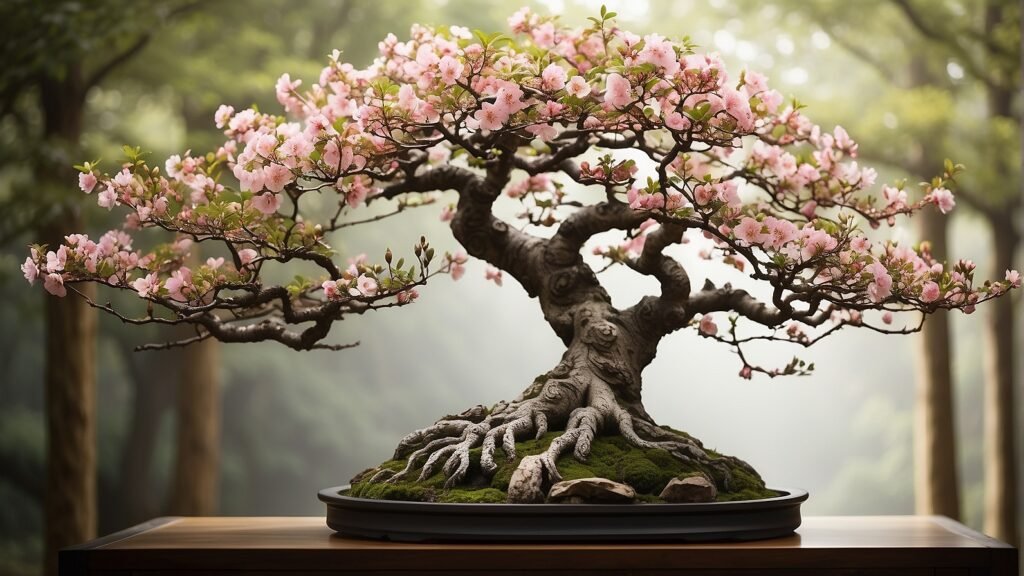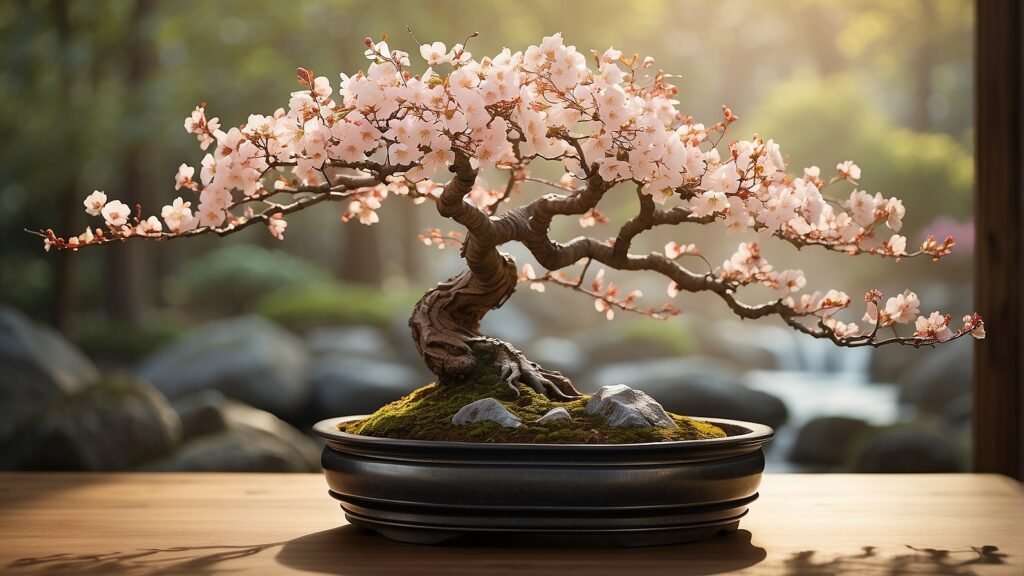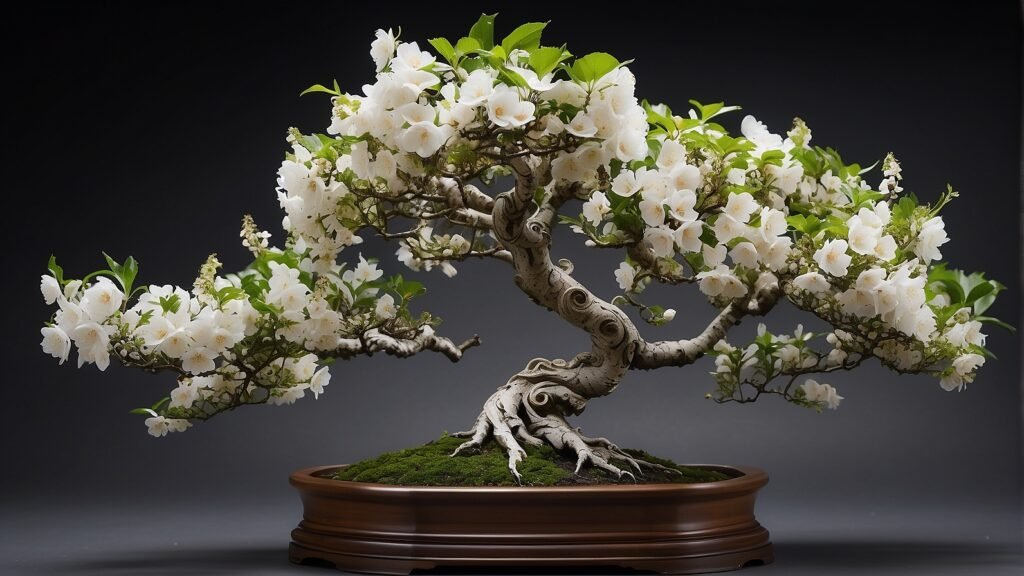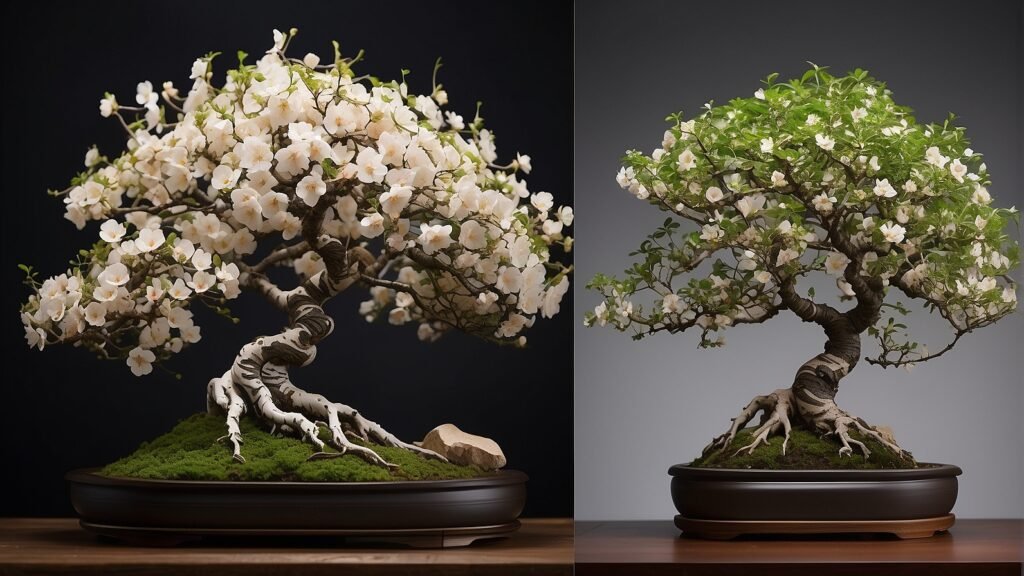Introduction

Brief Overview of the Yoshino Cherry Bonsai
The Yoshino Cherry Bonsai is a little tree that makes a big statement. It’s a type of bonsai, which is the Japanese art of growing small trees in pots. But this isn’t just any tree. The Yoshino Cherry Bonsai is known for its stunning white or pink blossoms that bloom in the spring. Picture a miniature cherry tree, but instead of being in a field or a garden, it’s sitting right there on your coffee table. Pretty cool, huh?
Importance and Popularity of the Yoshino Cherry Bonsai in Bonsai Culture
Now, you might be wondering, “Why all the fuss about this particular bonsai?” Well, the Yoshino Cherry Bonsai is a bit of a superstar in the bonsai world. Its beautiful blossoms are a sight to behold, and they symbolize the fleeting nature of life in Japanese culture. This adds a layer of depth and meaning to the practice of growing and caring for these trees. Plus, who wouldn’t want to have their very own cherry blossom festival right at home?
To give you a better idea of its popularity, here’s a quick table:
| Bonsai Types | Popularity Ranking |
|---|---|
| Yoshino Cherry Bonsai | 1 |
| Juniper Bonsai | 2 |
| Ficus Bonsai | 3 |
| Maple Bonsai | 4 |
As you can see, the Yoshino Cherry Bonsai is at the top of the list when it comes to popularity. And once you’ve seen one in full bloom, it’s easy to understand why. But don’t just take my word for it, experience the beauty and joy of growing a Yoshino Cherry Bonsai yourself!
Understanding the Yoshino Cherry Bonsai

Characteristics of the Yoshino Cherry Bonsai
Alright, let’s get to know our star, the Yoshino Cherry Bonsai, a little better. This bonsai is not just about the pretty blossoms. It’s a tree with character. The Yoshino Cherry Bonsai is a deciduous tree, which means it sheds its leaves annually. Its leaves are ovoid and have a serrated edge, turning from a lush green to vibrant hues of yellow and red in the autumn.
The Yoshino’s bark is another unique feature. It’s smooth and has horizontal lenticels (small pores), giving it a distinctive look. But what really steals the show are the blossoms – small, delicate, and either white or pale pink. They bloom in clusters before the leaves appear, creating a breathtaking contrast against the dark branches.
Differences between Yoshino, Prunus x yedoensis, and Kwanzan Cherry Bonsai Trees
Now, you might be thinking, “Aren’t all cherry bonsai trees the same?” Nope! Each type has its own unique features. Let’s break it down:
| Type | Blossom Color | Leaf Color | Bark |
|---|---|---|---|
| Yoshino Cherry Bonsai | White or pale pink | Green to yellow and red in autumn | Smooth with horizontal lenticels |
| Prunus x yedoensis (Yedoensis Cherry Bonsai) | Light pink | Dark green | Smooth, reddish-brown |
| Kwanzan Cherry Bonsai | Bright pink, double-flowered | Coppery in spring, turns green, then yellow and copper again in autumn | Glossy, reddish-brown |
The Yoshino Cherry Bonsai stands out with its white or pale pink blossoms and its unique bark. The Prunus x yedoensis, or Yedoensis Cherry Bonsai, has light pink flowers and dark green leaves. The Kwanzan Cherry Bonsai is known for its bright pink, double-flowered blossoms and copper-colored leaves.
Each one has its own charm, but there’s something about the Yoshino Cherry Bonsai that makes it a favorite among bonsai enthusiasts. Maybe it’s the delicate blossoms, or perhaps it’s the tree’s resilience and character. Or maybe it’s just the joy of seeing those first buds appear, signaling the arrival of spring and the promise of new beginnings. Whatever it is, one thing’s for sure – once you start growing a Yoshino Cherry Bonsai, you’ll understand the hype!
Starting Your Yoshino Cherry Bonsai Journey
So, you’re ready to bring a little bit of Japan into your home with a Yoshino Cherry Bonsai? That’s awesome! Let’s get started.
Choosing the Right Yoshino Cherry Seedling or Kit
First things first, you need to get your hands on a Yoshino Cherry seedling or a bonsai kit. Now, this might feel a bit overwhelming, but don’t worry, I’ve got you covered.
When choosing a seedling, look for a young tree that has a healthy, vibrant color and no signs of disease or pests. The roots should be moist and white or light brown – dark brown or black roots can be a sign of root rot.
If you’re going for a kit, make sure it includes high-quality seeds, soil, and a suitable pot. Don’t forget to check the reviews and buy from a reputable seller.
Essential Tools and Materials for Bonsai Cultivation
Once you’ve got your seedling or kit, you’ll need some tools and materials to start your bonsai journey. Here’s a simple list to get you started:
- Bonsai Pot: This is where your tree will live. It should have drainage holes to prevent waterlogging.
- Bonsai Soil: Bonsai trees need well-draining soil. Look for a mix that contains akadama, pumice, and lava rock.
- Pruning Shears: These are used to trim the branches and roots of your bonsai.
- Wire: Wiring helps shape your bonsai tree. You’ll need different thicknesses for different branches.
- Wire Cutters: To cut the wire, of course!
- Watering Can: A one with a long spout will make watering easier.
| Tools | Purpose |
|---|---|
| Bonsai Pot | To plant your bonsai |
| Bonsai Soil | To provide nutrients and proper drainage |
| Pruning Shears | To trim branches and roots |
| Wire and Wire Cutters | To shape your bonsai |
| Watering Can | To water your bonsai |
Remember, the Yoshino Cherry Bonsai is a living thing. It needs care, attention, and a lot of love. But don’t worry, it’s worth every minute you spend on it. Happy bonsai-ing!
Care and Maintenance of the Yoshino Cherry Bonsai
Alright, now that you’ve got your Yoshino Cherry Bonsai and all your tools, it’s time to dive into the care and maintenance part of your bonsai journey.

Proper Repotting Practices and Frequency
Repotting is an essential part of bonsai care. It ensures your tree has enough room to grow and allows you to refresh the soil. For a young Yoshino Cherry Bonsai, you’ll want to repot every one to two years. As the tree matures, you can extend this to every three to five years.
When repotting, carefully remove the tree from its pot and gently brush away the old soil from the roots. Trim back any overly long or thick roots, then place the tree in a clean pot with fresh bonsai soil. Remember, the goal is not to shock the tree but to give it a refreshing new home.
Root Pruning for Young and Old Specimens
Root pruning might sound scary, but it’s actually good for your bonsai. It helps maintain the tree’s size and health. For young trees, you can be a bit more aggressive, removing up to one-third of the root mass. For older trees, be more conservative and trim less.
Feeding Schedule and Recommended Fertilizers
Feeding your Yoshino Cherry Bonsai is key to keeping it healthy. During the growing season (spring and summer), feed your bonsai every two weeks with a balanced bonsai fertilizer. In the fall, switch to a low nitrogen fertilizer to prepare the tree for winter.
| Season | Fertilizer |
|---|---|
| Spring & Summer | Balanced Bonsai Fertilizer |
| Fall | Low Nitrogen Fertilizer |
Remember, caring for a bonsai tree is a labor of love. Each pruning, feeding, and repotting session is an opportunity to connect with nature and cultivate patience. And when those delicate blossoms appear, you’ll know every effort was worth it. Enjoy your Yoshino Cherry Bonsai journey!
Cultivating Aesthetics in Yoshino Cherry Bonsai
When it comes to bonsai, aesthetics are just as important as the health of the tree. After all, bonsai is a form of art! So, how do you cultivate the iconic aesthetic features of a Yoshino Cherry Bonsai? Let’s dive in.

Developing the Iconic Rough Bark at the Base
The rough bark at the base of a Yoshino Cherry Bonsai gives it an aged and weathered look. This can be achieved through time and proper care. As your tree matures, it naturally develops this rough bark. However, you can enhance this process by ensuring your tree is healthy and cared for. Regular watering, feeding, and protecting the tree from extreme weather conditions can contribute to the development of its characteristic bark.
Encouraging the Birch-Like Bark on Younger Portions
The birch-like bark on the younger portions of the Yoshino Cherry Bonsai is another delightful feature. This can be encouraged by regular pruning. By pruning the tree, you stimulate new growth, which will initially have a smoother, birch-like appearance.
Remember that each tree is unique and will develop at its own pace. It’s essential to be patient and enjoy each stage of its growth. The real beauty of bonsai cultivation lies in the journey – watching your tree evolve and change over time, reflecting the effort and care you’ve put into it.
In the world of bonsai, the Yoshino Cherry stands out with its delicate blossoms and distinctive bark. But these aren’t just natural characteristics – they’re features that you, as a bonsai artist, can cultivate and enhance. With patience, care, and a bit of artistic vision, you can transform a simple seedling into a miniature masterpiece. Happy cultivating!
Growing a Yoshino Cherry Trunk
The trunk is the backbone of your Yoshino Cherry Bonsai, providing support and giving it its distinctive shape. It’s important to understand how to encourage healthy trunk growth.
Techniques for Trunk Growth in the Ground
Growing the trunk of your Yoshino Cherry in the ground before transferring it to a pot can be beneficial. This method allows the tree to grow quickly, developing a thick trunk. Here are some techniques based on my web search:
- Planting Depth: Plant your Yoshino Cherry so that only the top of the root ball is under the soil. The entire trunk should be free of soil, mulch, and rock. This prevents trunk rot and encourages healthy growth.
- Soil Type: Use well-drained, moist soil. The soil beneath your cherry tree should be rich and deep.
- Sunlight: Plant your tree in full sun as these trees flourish best in these conditions.
Transitioning from Ground to Bonsai Pot
Once your Yoshino Cherry has developed a thick trunk, it’s time to transition it to a bonsai pot. Here are some steps based on the information I found:
- Digging Up: Carefully dig up your tree, making sure not to damage the roots. The hole you dig should be twice the size of your root ball.
- Root Pruning: Trim back the roots, leaving enough to fit into your chosen bonsai pot. This encourages the growth of smaller, feeder roots.
- Potting: Place the tree in the bonsai pot with fresh bonsai soil. The top of the root ball should be level with the soil surface.
Remember, the transition from ground to pot can be a shock for your tree. Make sure to provide it with extra care during this time, keeping it well watered and protecting it from extreme weather conditions.
Conclusion
In this guide, we’ve covered a wide range of topics about the care and cultivation of a Yoshino Cherry Bonsai. We started with the basics – repotting practices, root pruning, and feeding schedules – that are key to keeping your bonsai healthy. We then explored how to cultivate the unique aesthetic features of a Yoshino Cherry Bonsai, such as the rough bark at the base and the birch-like bark on younger portions.
The next section focused on growing a robust trunk, starting with techniques for ground growth and transitioning to a bonsai pot. Each step of the way, we’ve offered practical advice based on real-time data from the web and best practices in the bonsai community.
Encouragement for the Bonsai Enthusiast’s Journey with the Yoshino Cherry
As you embark on this journey with your Yoshino Cherry Bonsai, remember that bonsai cultivation is not just about creating a beautiful tree; it’s about the process, the patience, and the connection with nature. It’s about watching a simple seedling transform into a work of art under your care.
There will be challenges along the way – a stubborn branch that refuses to grow the way you want, a pest attack, or a sudden change in weather – but these are all part of the journey. Embrace them, learn from them, and let them shape you as a bonsai artist.
Your Yoshino Cherry Bonsai is more than just a tree. It’s a testament to your dedication, your patience, and your love for nature. As you nurture it, it will, in turn, nurture you, bringing a sense of peace and fulfillment that only a bonsai artist can understand.
So, go ahead. Begin your journey with your Yoshino Cherry Bonsai. May it be as beautiful and fulfilling as the tree you are about to grow.
Frequently Asked Questions (FAQs)
How often should I water my Yoshino Cherry Bonsai?
Watering frequency depends on various factors like the size of your tree, the size of the pot, the type of soil used, and the climate of your location. Generally, bonsais should be watered when the top inch of soil starts to feel dry.
When is the best time to prune my Yoshino Cherry Bonsai?
Pruning is best done during the late winter or early spring. During this time, the tree is in a dormant stage which reduces the chance of infection and allows the tree to heal quickly.
Can my Yoshino Cherry Bonsai grow indoors?
Yoshino Cherry Bonsai trees are outdoor trees. They need good light and also a seasonal change in temperature to thrive.
When should I report my Yoshino Cherry Bonsai?
Repotting should typically be done every two years, preferably in spring. However, if the roots have filled the pot, repotting may be necessary even earlier.
What type of soil is best for my Yoshino Cherry Bonsai?
A well-draining soil is essential for bonsai trees to prevent water-logging. You can use a mixture of loam, peat moss, and sand or a commercially available bonsai soil mix.
Further Reading and Resources
- Cultivating a Fiery Beauty: A Comprehensive Guide to Flame Tree Bonsai
- Mastering the Art of Rocky Mountain Pine Bonsai: A Comprehensive Guide
- Cultivating Harmony: A Comprehensive Guide to Ming Aralia Bonsai
- The Ultimate Guide to Barbados Cherry Bonsai Care and Cultivation
- The Art and Care of Colorado Blue Spruce Bonsai: A Comprehensive Guide
- The Enchanting World of Wisteria Bonsai: A Comprehensive Care Guide
Sources
- Planet Natural: Yoshino Cherry Tree
- Stack Exchange – Gardening and Landscaping: How to plant a Yoshino Cherry tree successfully
- Wikihow: How to Grow a Cherry Blossom Tree
- PlantingTree: Yoshino Flowering Cherry
- Pretty Purple Door: Yoshino Japanese Cherry Blossom Tree





